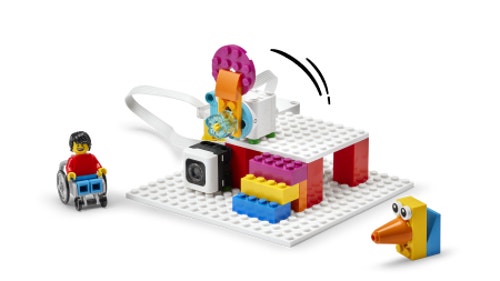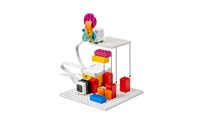Classify and Choose Materials
Daniel got some chickens. Help him build a chicken coop where they’ll be safe and comfortable.

Prepare
(NOTE: This lesson contains a Part A and a Part B. Both are important to access the full learning of the standard. If time is limited, review both parts to choose elements that meet your students’ needs.)
In this lesson, the key learning is to plan and conduct an investigation to observe and then classify materials. Designing and building a model offers some guiding purposes for that classification and a fun, hands-on way to use the selected materials. The lesson provides an example purpose and model for inspiration—a safe and comfortable chicken house. Encourage students to design and build their own ideas.
You may want to allocate materials sorting by group to save time and then have students share findings. Prioritize time for sorting, observing, and classifying.
- Science Background - Classify and Choose Materials: In this lesson, students plan and conduct an investigation to sort materials for a specific purpose, which is building a chicken coop. In Elaborate, they can repeat the investigation to sort materials to shelter an animal of their choice.
- Build Prior Knowledge - Classify and Choose Materials: Using your core science materials and the provided background, share information, images, and definitions. Consider including pictures of chicken coops and examples of craft materials.
- Materials have properties (e.g., strength, flexibility, hardness, texture, or absorbency). We can observe some of them.
- Chicken coops protect chickens from weather and predators. They also provide chickens with a nesting place to sleep and lay eggs. Chicken coops have a way for the chickens to go outside to eat grass and bugs and come inside for sleeping.
- Key vocabulary: properties, materials, coop, shelter
- Building and Programming Experience: Use the suggestions in the Unit Plan. For this lesson, you may also want to
- Reinforce with the Motor and Color Sensor tutorials in the SPIKE App Start Menu
- Use the Event, Motor, and Color Sensor Blocks sections of the Help>Icon Blocks menu in the SPIKE app to provide more support.
- Materials:
- Collect an assortment of LEGO® elements and craft materials with different properties (strength, flexibility, hardness, texture, and absorbency) for students to test, sufficient that groups can test 10 materials (group selections may overlap). Examples include waterproof materials for the roof (e.g., LEGO bricks), transparent materials for the windows or fence, and soft materials like cotton balls to represent hay in the nesting box. Decide how students should access them.
- Locate pictures of chicken coops to help students see common features and build criteria for sorting.
- To support investigation results for young students, consider providing boxes, bins, or wall charts labeled with words or pictures corresponding to the observable properties.
- For Elaborate, locate or provide information about the needs of other animals for which people may make shelters, such as a bird, rabbit, or horse, etc.
- For Differentiation, collect images, information, or examples of recycled materials such as used paper, paper cups, plastic like straws or bottles, or glass bottles.
PART A (45 Minutes)
Engage
(Whole Class, 10 minutes)

Introduce the story’s main character(s) and the first challenge: Daniel got some chickens. Help him build a chicken coop where they’ll be safe and comfortable.
THINK—Facilitate a brief discussion about the lesson topic(s), using the background pictures and box of collected materials/elements.
- Look at these pictures of chicken coops. What might chickens need in their coop? How will this keep them safe and comfortable? (Possible answers: a dry place to sleep, a nesting place to lay eggs, space for eating and drinking, a roof for protection from weather, a fence and walls for protection from other animals, a way to get out for food and freshair; They’ll be safe if the coop protects them from weather and other animals. They’ll be comfortable if they have a warm, dry, soft nest for resting or hatching eggs and a big outdoor area for fresh air and food.)
- What kind of materials would help you build a chicken coop that is safe and comfortable? (Possible answers: strong, rigid, and hard materials for the nesting place and walls; strong and waterproof material for the roof; strong wire for the fencing; soft material for hay inside the nesting place, and dirt on the ground.)
- Examine the materials in the box. What are they like? (Possible answers: strong; flexible; hard, soft, or bumpy; transparent; absorbent. These qualities are called properties.)
- Think of a way to learn more about these materials so you can find the ones you need to build a safe and comfortable chicken coop.
Distribute a SPIKE™ Essential Set and device to each group.
Explore
(Small Groups, 35 minutes)
As students work, consider sharing the examples below as support for building or programming. Clarify that images show one purpose for observing and classifying materials along with different solutions for using them in response. Students may choose their own purpose and design their own ideas for a chicken coop, using those choices to drive their investigation plans.
Have students:
- Plan a way to test and sort 10 materials from the box.
- Use what they observed during Engage about the materials, such as softness or strength. Were they soft or hard? Strong or flexible?
- Describe the materials, using words or pictures.
- Sort the materials into categories, using words, pictures, or a physical method you share (see Prepare).
- Choose the ones they want for a chicken coop. Which will keep the chickens safe? Which will make them comfortable? Why?
- Use the base model and selected craft materials to BUILD a chicken coop where the chicken is safe and comfortable.
- PROGRAM their model so the door of the coop opens and closes to keep the chickens safe in the coop.
As they plan and test, guide students to connect the properties they observe with keeping the chickens safe and keeping them comfortable. Review and clarify the desired sorting procedures—see Prepare.
Facilitate brainstorming about how students can do the following:
- Test materials, such as using their fingers or face to feel which materials feel warmest and softest or using a scale to weigh different waterproof materials to see which is lightest to use as a roof.
- Use the SPIKE™ Essential Set with different craft materials for the chicken coop. Examples could include waterproof materials for the roof, transparent materials for the windows or fence, and soft materials like cotton balls to represent hay in the nesting box.
- Build/program an automatic door for the chicken coop.
Halfway through work time, have students exchange ideas using a familiar classroom routine and then update their models with inspiration from sharing.
Example Ideas




PART B (45 Minutes)
Explain
(Whole Class, 10 minutes)
Gather students for sharing.
Have each group use their model to demonstrate and explain:
- Their list of materials.
- How they tested and sorted the materials.
- The properties of three different materials they used for the chicken coop
- Why they chose these materials for the chicken coop. (For example, “Cotton balls are soft and warm. You place them on the floor in the coop so the chicken can rest or hatch eggs on it.”)
Invite students to share how they updated their model to improve its performance.
Elaborate
(Whole Class, 30 minutes)
(5 min) Share background to help students Elaborate:
- Provide information about the needs of other animals that people may make shelters for, such as a bird, rabbit, or horse, etc.
- Help students list and sort material properties they might need for one such shelter, adding to their sorting list for the chicken coop.
(20 min) Have your students iterate and test their models to complete the next challenge in the app:
- Choose another animal. What does it need for its shelter?
- Choose materials and build the shelter. (Encourage them to use their sorting list to choose suitable materials)
- Program the shelter to keep the animal safe and comfortable.
(5 min) Invite students to share knowledge, ideas, or skills that:
- Helped them complete the challenge.
- They learned while building.
Have students clean up the sets and work areas.
Evaluate
(Whole Class, 5 minutes)
- Ask guiding questions to elicit students’ thinking and their decisions while ideating, building, and programming.
Observation Checklist
Review the key objectives (Teacher Support box).
Share specific student responses and behaviors at different levels of mastery.
Use the checklist to observe students’ progress:
- Their description identifies the relevant properties of different provided materials.
- Their testing plan includes a way to observe and sort the materials according to properties they identify.
- Their sorting correctly reflects the relevant properties and sorting categories.
- Their explanation reflects a logical choice of materials with properties suitable for different parts of the chicken coop.
Self-Assessment
Have each student choose the brick that they feel best represents their performance。
- Blue brick: I think I can follow instructions to create a program.
- Yellow brick: I can follow instructions to create a program.
- Green brick: I can follow instructions to create a program, and I can help a friend do it too.
Peer-Feedback
In their small groups, have your students discuss their experiences working together.
Encourage them to use statements like these:
- I liked it when you…
- I’d like to hear more about how you…
Differentiation
Simplify this lesson by:
- Using either/or questions (Is this hard or soft?) to support students in categorizing and in choosing materials for the chicken coop (Will this keep the chicken safe?).
Increase the difficulty by:
- Encouraging students to discuss what materials can be recycled and whether they can use recycled materials to build the chicken coop. Have them test their ideas with some recycled materials.
Extension
- Have students create coop building instructions with labeled drawings that show the steps and sequence to build their chicken coop. Have them list materials, including the lengths of any LEGO® Elements and how many of each are needed.
If facilitated, this will extend beyond the 45-minute lesson
Language Arts: CCSS.ELA.LITERACY.W.2.2
Math: CCSS.MATH.CONTENT.2.MD.A.1; CCSS.MATH.PRACTICE.MP5
Teacher Support
Students will:
- Describe the properties of different kinds of materials.
- Plan and conduct an investigation to classify materials by their properties.
- Collect and record data on the properties of materials.
- Build a model that incorporates materials with appropriate properties for building a chicken coop.
(one for every two students)
- LEGO® Education SPIKE™ Essential Set
- Device with the LEGO Education SPIKE App installed
- See Prepare - Materials.
- NGSS 2-PS1-1: Plan and conduct an investigation to describe and classify different kinds of materials by their observable properties.
- NGSS K-2-ETS1-1
- CSTA 1A-AP-10
- ISTE 1.4.c
- CCSS.ELA.LITERACY.SL.2.1
- CCSS.MATH.CONTENT.2.OA.B.2
Language Arts and Math Extension
- CCSS.ELA.LITERACY.W.2.2
- CCSS.MATH.CONTENT.2.MD.A.1
- CCSS.MATH.PRACTICE.MP5